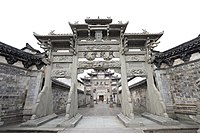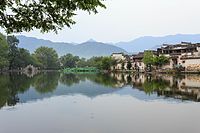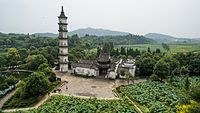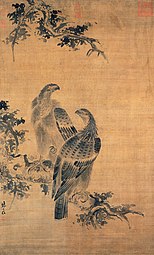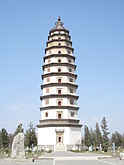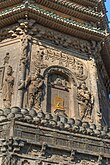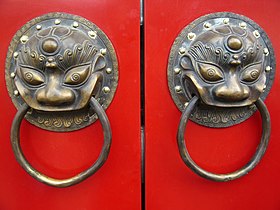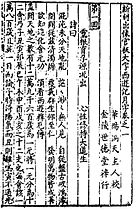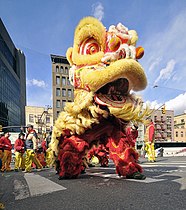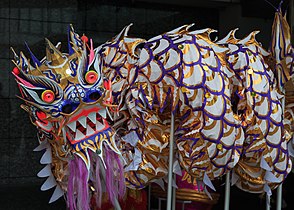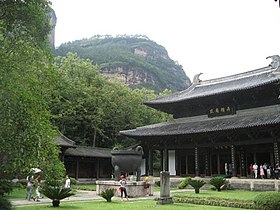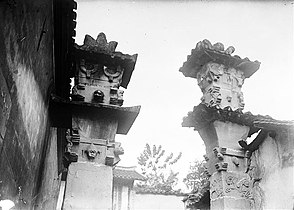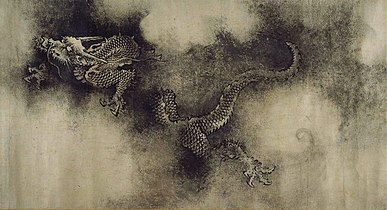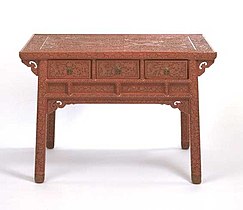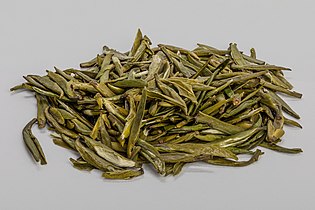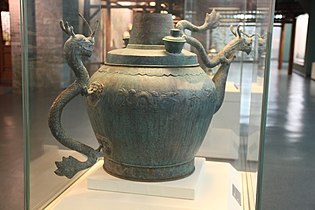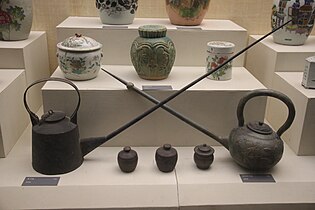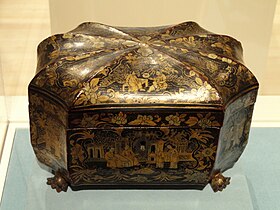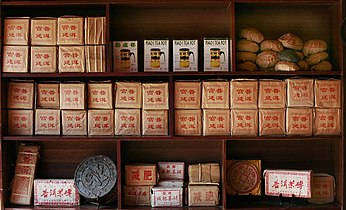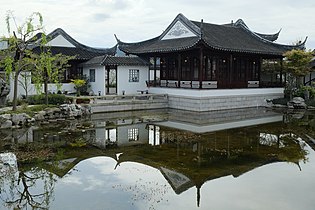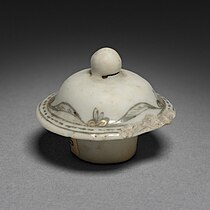Chinese culture
This article has multiple issues. Please help improve it or discuss these issues on the talk page. (Learn how and when to remove these template messages)
|
| Part of Culture of China |
 |
| Mythology and Folklore |
|---|
| Cuisine |
|
Festivals |
| Music and Performing arts |
Chinese culture (
Chinese civilization is historically considered a dominant culture of East Asia.
Identity
As early as the Zhou dynasty, the Chinese government divided Chinese people into four classes: gentry, farmer, craftsman, and merchant. Gentry and farmers constituted the two major classes, while merchant and craftsmen were collected into the two minor. Theoretically, except for the position of the Emperor, nothing was hereditary.[citation needed]
China's majority ethnic group, the
In modern China, there are 56 officially labelled ethnic groups.[10] Throughout Chinese history, many non-Han foreigners like the Indo-Iranians became Han Chinese through assimilation, other groups retained their distinct ethnic identities, or faded away.[11] At the same time, the Han Chinese majority has maintained distinct linguistic and regional cultural traditions throughout the ages. The term Zhonghua minzu (simplified Chinese: 中华民族; traditional Chinese: 中華民族) has been used to describe the notion of Chinese nationalism in general. Much of the traditional identity within the community has to do with distinguishing the family name.
The Characteristics of Chinese Culture
The chapter discusses the contemporary situations in Chinese culture that relate to social structure, sociocultural change, and the relationship of these factors to the current state of mental health of the Chinese people. The chapter focuses on the issues of mind, body, and behavior. The cultural framework is of central concern to Chinese participants, whether they are social scientists, humanists, or clinical psychiatrists. Chinese culture appears to affect the state of body and health, parent–child interaction, social relationships, individual and group aspirations, models of health care services, and the patterns of disorders and methods of coping under the impact of migration, industrialization, and urbanization. The chapter focuses on the importance of the impact of cultural tradition upon perception, behavioral orientation, pathology, coping, and help-seeking. The mental health concerns that are relevant to the population of mainland China are related to the recent dramatic socialist revolution and particularly to the 10-year period of the Cultural Revolution.[12]
Abstract
Chinese civilization is the only one that has preserved its historical continuity among the world’s “cradles for four ancient civilizations.” In the long process of civilization evolution, the Chinese people, in the spirit of “continuous self-renewal,” “self-discipline and social commitment,” “inclusiveness to diversity,” and “realism and adaptation to changes,” created cultural traditions of abundant contents, sophisticated structures, and various forms. These traditions have since been nourishing, nurturing, and shaping the Chinese people and become internalized in the blood and soul of the Chinese nation.[13]
Regional
During the 361 years of civil war after the
Social structure
Since the
However, this system did not cover all social groups and the distinctions between the groups became blurred after the
With the rise of European economic and military power beginning in the mid-19th century, non-Chinese systems of social and political organization gained adherents in China. Some of these would-be reformers totally rejected China's cultural legacy, while others sought to combine the strengths of Chinese and European cultures. In essence, the history of 20th-century China is one of experimentation with new systems of social, political, and economic organization that would allow for the reintegration of the nation in the wake of dynastic collapse.[citation needed]
Spiritual values
Most spiritual practices are derived from
Chinese Buddhism has shaped some Chinese art, literature and philosophy. The translation of a large body of foreign Buddhist scriptures into Chinese and the inclusion of these translations, together with works composed in China, into a printed canon had far-reaching implications for the dissemination of Buddhism throughout China. Chinese Buddhism is also marked by the interaction between Indian religions, Chinese folk religion, and Taoism.
Religion
During the Xia and Shang dynasties, Chinese religion was oriented to worshipping the supreme god
Taoism, a religious or philosophical tradition of Chinese origin, emphasizes living in harmony with the Tao (道, literally "Way", also romanized as Dao). The Tao is a fundamental idea in most Chinese philosophical schools; in Taoism, however, it denotes the principle that is the source, pattern and substance of everything that exists.[22][23] Taoism differs from Confucianism by not emphasizing rigid rituals and social order.[22] Taoist ethics vary depending on the particular school, but in general tend to emphasize wu wei (effortless action), "naturalness", simplicity, spontaneity, and the Three Treasures: 慈 "compassion", 儉/俭 "frugality", and 谦 "humility". The roots of Taoism can be traced back to at least the 4th century BCE. Early Taoism drew its cosmological notions from the School of Yinyang (Naturalists), and was deeply influenced by one of China's oldest texts, the Yijing, which expounds a philosophical system of human behavior in accordance with the alternating cycles of nature. The "Legalist" Shen Buhai may also have been a major influence, expounding a realpolitik of wu wei.[23][24][25] The Tao Te Ching, a compact book containing teachings attributed to Laozi (Chinese: 老子; pinyin: Lǎozǐ; Wade–Giles: Lao Tzu), is widely considered the keystone work of the Taoist tradition, together with the later writings of Zhuangzi.
Philosophy and legalism
Confucianism, also known as Ruism, was the official philosophy throughout most of
Confucianism is described as tradition, a philosophy, a religion, a humanistic or rationalistic religion, a way of governing, or simply a way of life.
Hundred Schools of Thought

The Hundred Schools of Thought were philosophies and schools that flourished from the 6th century to 221 BC, during the
Mohism was an
His theory attempted to explain the universe in terms of basic forces in nature: the complementary agents of yin (dark, cold, female, negative) and yang (light, hot, male, positive) and the Five Elements or Five Phases (water, fire, wood, metal, and earth).Language
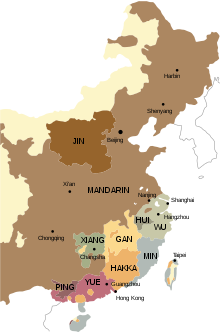
The ancient written standard was
Chinese philosophers, writers and poets were highly respected and played key roles in preserving and promoting the culture of the empire. Some classical scholars, however, were noted for their daring depictions of the lives of the common people, often to the displeasure of authorities.
Varieties of dialect and writing system
At the start of the 20th century, most of the population were still
Calligraphy
Chinese calligraphy is a form of writing (

In China, calligraphy is referred to as Shūfǎ (書法/书法), literally "the way/method/law of writing".
Literature
The
Poetry in the Tang dynasty
Tang poetry refers to poetry written in or around the time of, or in the characteristic style of, China's Tang dynasty (18 June 618 – 4 June 907, including the 690–705 reign of Wu Zetian) or that follows a certain style, often considered the Golden Age of Chinese poetry. During the Tang dynasty, poetry continued to be an important part of social life at all levels of society. Scholars were required to master poetry for the civil service exams, but the art was theoretically available to everyone.[39] This led to a large record of poetry and poets, a partial record of which survives today. Two of the most famous poets of the period were Li Bai and Du Fu. Tang poetry has had an ongoing influence on world literature and modern and quasi-modern poetry. The Quantangshi ("Complete Tang Poems") anthology compiled in the early eighteenth century includes over 48,900 poems written by over 2,200 authors.[40]
The Quantangwen (全唐文, "Complete Tang Prose"), despite its name, contains more than 1,500
Ci in Song dynasty
Ci (辭/辞) are a poetic form, a type of
Qu in Yuan dynasty
The Qu form of poetry is a type of
The novels in Ming dynasty and Qing dynasty
The Four Great Classical
Chinese fiction, rooted in narrative classics such as
The rise of a money economy and urbanization beginning in the Song era led to a professionalization of entertainment which was further encouraged by the spread of printing, the rise of literacy, and education. In both China and Western Europe, the novel gradually became more autobiographical and serious in exploration of social, moral, and philosophical problems. Chinese fiction of the late
Fashion and clothing
China's fashion history covers hundreds of years with some of the most colorful and diverse arrangements. Different social classes in different eras boast different fashion trends, the color yellow was usually reserved for the emperor during China's Imperial era.
Pre-Qing
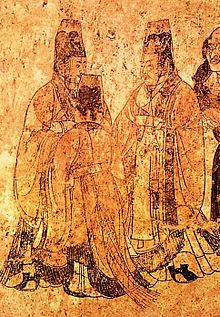
From the beginning of its history,
Qipao
During the
Arts
Chinese art is
Chinese art has arguably the oldest continuous tradition in the world, and is marked by an unusual degree of continuity within, and consciousness of, that tradition, lacking an equivalent to the Western collapse and gradual recovery of classical styles. The media that have usually been classified in the West since the Renaissance as the decorative arts are extremely important in Chinese art, and much of the finest work was produced in large workshops or factories by essentially unknown artists, especially in Chinese ceramics.
Different forms of art have swayed under the influence of great philosophers, teachers, religious figures and even political figures. Chinese art encompasses all facets of
Chinese lantern

The Chinese paper lantern (紙燈籠, 纸灯笼) is a
The Chinese sky lantern (天燈, 天灯), also known as Kongming lantern, is a small hot air balloon made of paper, with an opening at the bottom where a small fire is suspended. In Asia and elsewhere around the world, sky lanterns have been traditionally made for centuries, to be launched for play or as part of long-established festivities. The name "sky lantern" is a translation of the Chinese name but they have also been referred to as sky candles or fire balloons. The general design is a thin paper shell, which may be from about 30 cm to a couple of metres across, with an opening at the bottom. The opening is usually about 10 to 30 cm wide (even for the largest shells), and is surrounded by a stiff collar that serves to suspend the flame source and to keep it away from the walls. When lit, the flame heats the air inside the lantern, thus lowering its density and causing the lantern to rise into the air. The sky lantern is only airborne for as long as the flame stays alight, after which the lantern sinks back to the ground.
Chinese hand fan

The oldest existing Chinese fans are a pair of woven
Carved lacquer
Carved lacquer or Qīdiāo (Chinese: 漆雕) is a distinctive Chinese form of decorated lacquerware. While lacquer has been used in China for at least 3,000 years,[56] the technique of carving into very thick coatings of it appears to have been developed in the 12th century CE. It is extremely time-consuming to produce, and has always been a luxury product, essentially restricted to China,[57] though imitated in Japanese lacquer in somewhat different styles. The producing process is called Diāoqī (雕漆/彫漆, carving lacquer).Though most surviving examples are from the Ming and Qing dynasties, the main types of subject matter for the carvings were all begun under the Song dynasty, and the development of both these and the technique of carving were essentially over by the early Ming. These types were the abstract guri or Sword-Pommel pattern, figures in a landscape, and birds and plants. To these some designs with religious symbols, animals, auspicious characters (right) and imperial dragons can be added.[56] The objects made in the technique are a wide range of small types, but are mostly practical vessels or containers such as boxes, plates and trays. Some screens and pieces of Chinese furniture were made. Carved lacquer is only rarely combined with painting in lacquer and other lacquer techniques.[58]
Later Chinese writers dated the introduction of carved lacquer to the
Folding screen

A folding screen (
Folding screens were originally made from wooden panels and painted on
Chinese jade

Chinese jade (玉) refers to the
Mythological beings
Loong

Loongs, also known as Chinese Dragon, are
Fenghuang

Fenghuang (鳳凰) are mythological birds found in Chinese and East Asian mythology that reign over all other birds. The males were originally called feng and the females huang but such a distinction of gender is often no longer made and they are blurred into a single feminine entity so that the bird can be paired with the Chinese dragon, which is traditionally deemed male. The fenghuang is also called the "August Rooster" (simplified Chinese: 鹍鸡; traditional Chinese: 鶤雞 or 鵾雞; pinyin: yùnjī or kūnjī; Wade–Giles: yün4-chi1 or k'un1-chi1) since it sometimes takes the place of the Rooster in the Chinese zodiac.[citation needed] In the Western world, it is commonly called the Chinese phoenix or simply Phoenix, although mythological similarities with the Western phoenix are superficial[citation needed].
Qilin

The Qilin (
Xuanwu
Xuanwu (
) portrayed in the company of a turtle and snake.Music, instruments and dancing
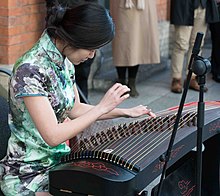
Music and dance were closely associated in the very early periods of China. The music of China dates back to the dawn of Chinese civilization with documents and artifacts providing evidence of a well-developed musical culture as early as the Zhou dynasty (1122 BCE – 256 BCE). The earliest music of the Zhou dynasty recorded in ancient Chinese texts includes the ritual music called yayue and each piece may be associated with a dance. Some of the oldest written music dates back to Confucius's time. The first major well-documented flowering of Chinese music was exemplified through the popularization of the qin (plucked instrument with seven strings) during the Tang dynasty, although the instrument is known to have played a major role before the Han dynasty.
There are many musical instruments that are integral to Chinese culture, such as the Xun (Ocarina-type instrument that is also integral in Native American cultures), Guzheng (zither with movable bridges), guqin (bridgeless zither), sheng and xiao (vertical flute), the erhu (alto fiddle or bowed lute), pipa (pear-shaped plucked lute), and many others.
Dance in China is a highly varied art form, consisting of many modern and traditional dance genres. The dances cover a wide range, from folk dances to performances in opera and ballet, and may be used in public celebrations, rituals and ceremonies. There are also 56 officially recognized
Architecture
Chinese architecture is a style of
Chinese palace
The Chinese palace is an imperial complex where the royal court and the civil government resided. Its structures are considerable and elaborate. The Chinese character gong (宮; meaning "palace") represents two connected rooms (呂) under a roof (宀). Originally the character applied to any residence or mansion, but it was used in reference to solely the imperial residence since the
Paifang
Paifang, also known as a Pailou, is a traditional style of Chinese architectural arch or gateway structure that is related to the Indian Torana from which it is derived.[82] The word paifang (Chinese: 牌坊; pinyin: páifāng) was originally a collective term for the top two levels of administrative division and subdivisions of ancient Chinese cities. The largest division within a city in ancient China was a fang (坊; fāng), equivalent to a current day ward. Each fang was enclosed by walls or fences, and the gates of these enclosures were shut and guarded every night. Each fang was further divided into several pai (牌; pái; 'placard'), which is equivalent to a current day (unincorporated) community. Each pai, in turn, contained an area including several hutongs (alleyways). This system of urban administrative division and subdivision reached an elaborate level during the Tang dynasty, and continued in the following dynasties. For example, during the Ming dynasty, Beijing was divided into a total of 36 fangs. Originally, the word paifang referred to the gate of a fang and the marker for an entrance of a building complex or a town; but by the Song dynasty, a paifang had evolved into a purely decorative monument.
Chinese garden

The Chinese garden is a landscape garden style which has evolved over the years.[83] It includes both the vast gardens of the Chinese emperors and members of the imperial family, built for pleasure and to impress, and the more intimate gardens created by scholars, poets, former government officials, soldiers and merchants, made for reflection and escape from the outside world. They create an idealized miniature landscape, which is meant to express the harmony that should exist between man and nature.[81] A typical Chinese garden is enclosed by walls and includes one or more ponds, rock works, trees and flowers, and an assortment of halls and pavilions within the garden, connected by winding paths and zig-zag galleries. By moving from structure to structure, visitors can view a series of carefully composed scenes, unrolling like a scroll of landscape paintings. The earliest recorded Chinese gardens were created in the valley of the Yellow River, during the Shang dynasty (1600–1046 BC). These gardens were large enclosed parks where the kings and nobles hunted game, or where fruit and vegetables were grown. Early inscriptions from this period, carved on tortoise shells, have three Chinese characters for garden, you, pu and yuan. You was a royal garden where birds and animals were kept, while pu was a garden for plants. During the Qin dynasty (221–206 BC), yuan became the character for all gardens.[84]

The old character for yuan is a small picture of a garden; it is enclosed in a square which can represent a wall, and has symbols which can represent the plan of a structure, a small square which can represent a pond, and a symbol for a plantation or a pomegranate tree.[85] According to the Shiji, one of the most famous features of this garden was the Wine Pool and Meat Forest (酒池肉林). A large pool, big enough for several small boats, was constructed on the palace grounds, with inner linings of polished oval shaped stones from the sea shores. The pool was then filled with wine. A small island was constructed in the middle of the pool, where trees were planted, which had skewers of roasted meat hanging from their branches. King Zhou and his friends and concubines drifted in their boats, drinking the wine with their hands and eating the roasted meat from the trees. Later Chinese philosophers and historians cited this garden as an example of decadence and bad taste.[86]: 11 During the Spring and Autumn period (722–481 BC), in 535 BC, the Terrace of Shanghua, with lavishly decorated palaces, was built by King Jing of the Zhou dynasty. In 505 BC, an even more elaborate garden, the Terrace of Gusu, was begun. It was located on the side of a mountain, and included a series of terraces connected by galleries, along with a lake where boats in the form of blue dragons navigated. From the highest terrace, a view extended as far as Lake Tai, the Great Lake.[86]: 12
Martial arts
China is one of the
Chinese martial arts are collectively given the name
Leisure
A number of
Qigong is the practice of spiritual, physical, and medical techniques. It is as a form of exercise and although it is commonly used among the elderly, any one of any age can practice it during their free time.
Cuisine
Chinese cuisine is a very important part of Chinese culture, which includes cuisine originating from the diverse regions of China, as well as from Chinese people in other parts of the world. Because of the Chinese diaspora and historical power of the country, Chinese cuisine has influenced many other cuisines in Asia, with modifications made to cater to local palates.[87] Seasoning and cooking techniques of Chinese provinces depend on differences in historical background and ethnic groups. Geographic features including mountains, rivers, forests and deserts also have a strong effect on the local available ingredients, considering climate of China varies from tropical in the south to subarctic in the northeast. Imperial, royal and noble preference also plays a role in the change of Chinese cuisines. Because of imperial expansion and trading, ingredients and cooking techniques from other cultures are integrated into Chinese cuisines over time. The most praised "Four Major Cuisines" are Chuan, Lu, Yue and Huaiyang, representing West, North, South and East China cuisine correspondingly.[88] Modern "Eight Cuisines" of China[89] are Anhui, Cantonese, Fujian, Hunan, Jiangsu, Shandong, Sichuan, and Zhejiang cuisines.[90] Color, smell and taste are the three traditional aspects used to describe Chinese food,[91] as well as the meaning, appearance and nutrition of the food. Cooking should be appraised from ingredients used, cuttings, cooking time and seasoning. It is considered inappropriate to use knives on the dining table. Chopsticks are the main eating utensils for Chinese food, which can be used to cut and pick up food.
Tea culture

The practice of drinking tea has a long history in China, having originated there.[92] The history of tea in China is long and complex, for the Chinese have enjoyed tea for millennia. Scholars hailed the brew as a cure for a variety of ailments; the nobility considered the consumption of good tea as a mark of their status, and the common people simply enjoyed its flavour. In 2016, the discovery of the earliest known physical evidence of tea from the mausoleum of Emperor Jing of Han in Xi'an was announced, indicating that tea from the genus Camellia was drunk by Han dynasty emperors as early as 2nd century BC.[93] Tea then became a popular drink in the Tang (618–907) and Song (960–1279) Dynasties.[94]
Although tea originated in China, during the Tang dynasty, Chinese tea generally represents tea leaves which have been processed using methods inherited from
Chinese tea culture refers to how tea is prepared as well as the occasions when people consume tea in China. Tea culture in China differs from that in European countries such as
Food culture
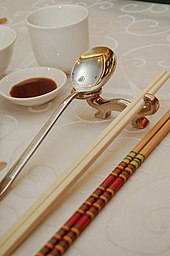
Manhan Quanxi, literally Manchu Han Imperial Feast was one of the grandest meals ever documented in Chinese cuisine. It consisted of at least 108 unique dishes from the
Major subcultures
Chinese culture consists of many subcultures. In China, the cultural difference between adjacent provinces (and, in some cases, adjacent counties within the same province) can often be as big as than that between adjacent European nations.[100] Thus, the concept of Han Chinese subgroups (漢族民系/汉族民系, literally "Han ethnic lineage") was born, used for classifying these subgroups within the greater Han ethnicity. These subgroups are, as a general rule, classified based on linguistic differences.
Using this linguistic classification, some of the well-known subcultures within China include:
North
- Hui culture
- Culture of Beijing (京)
- Culture of Shandong(魯/鲁)
- Culture of Gansu
- Dongbei culture (東北/东北)
- Shaanxi culture
- Zhongyuan culture (豫)
South
- Haipai culture(海)
- Hakka culture (客)
- Hokkien culture (閩)
- Hong Kong culture (港)
- Hubei culture (楚)
- Huizhou culture (徽)
- Hunanese culture (湘)
- Jiangxi culture (贛)
- Jiangnan culture
- Lingnan culture(粵/粤)
- Macanese culture
- Sichuanese culture(蜀)
- Taiwanese culture (台)
- Teochew culture(潮)
- Wenzhou culture (欧)
- Wuyue culture (吳/吴)
Gallery
-
A traditional red Chinese door withImperial guardian lionknocker
-
Journey to the West (西遊記/西游记)
-
Xiqu performance
-
Lion dance (舞狮)
-
Dragon dance (舞龙)
-
Taoist architecture in China
-
Wooden sculpture of Guanyin
-
temple dedicated to the Warring States period general Ba Manzi
-
Traditional clothing from the Ming dynasty
-
Hair Ornament, China, c. 19th century
-
Koi Pondis a signature scenery depicted in Chinese gardens
-
Oolong tea leaves steeping in a gaiwan
-
Ming table in the Victoria and Albert Museum, 1425–1436
-
Zhu-Ye-Qing-Tea
-
Dragon Tea Pot, Republic of China
-
Tea Pots, Republic of China
-
Laoshan green tea
-
Tea caddy, Chinese - Indianapolis Museum of Art
-
Chinese tea
-
Main hall and tea house in Dunedin Chinese Garden
-
Chinese Export—European Market, 18th century - Tea Caddy (lid)
-
Ancient China's Tea Pots
See also
- Bian Lian
- Chinese animation
- Chinese ancestral veneration
- Chinese art
- Chinese Buddhism
- Chinese cinema
- Chinese clothes
- Chinese food
- Chinese dance
- Chinese dragon
- Chinese drama
- Chinese festival
- Chinese folklore
- Chinese folk religion
- Chinese garden
- Chinese instrument
- Chinese jade
- Chinese literature
- Chinese marriage
- Chinese name
- Chinese opera
- Chinese orchestra
- Chinese paper cutting
- Chinese sphere of influence
- Chinese studies
- Color in Chinese culture
- Customs and etiquette in Chinese dining
- Go
- I Ching's influence
- Numbers in Chinese culture
- Peking opera
- Science and technology in China
- Chinese astronomy
- Chinese calendar
- Chinese mathematics
- Chinese medicine
- Chinese units of measurement
- Taoism
- Tian-tsui
- Xiangqi
Notes
References
- ^ "Chinese Dynasty Guide – The Art of Asia – History & Maps". Minneapolis Institute of Art. Archived from the original on 6 October 2008. Retrieved 10 October 2008.
- ^ "Guggenheim Museum – China: 5,000 years". Solomon R. Guggenheim Foundation & Solomon R. Guggenheim Museum. Archived from the original on 9 October 2009. Retrieved 10 October 2008.
- ^ Walker, Hugh Dyson (2012). East Asia: A New History. AuthorHouse. p. 2.
- ^ Wong, David (2017). "Chinese Ethics". The Stanford Encyclopedia of Philosophy. Metaphysics Research Lab, Stanford University. Archived from the original on 11 March 2017. Retrieved 16 September 2017.
- ^ "Chinese Culture, Tradition, and Customs – Penn State University and Peking University". elements.science.psu.edu. Archived from the original on 18 March 2019. Retrieved 10 September 2017.
- ^ "The original and unique culture of China". www.advantour.com. Archived from the original on 10 September 2017. Retrieved 10 September 2017.
- ^ "Chinese Culture: Ancient China Traditions and Customs, History, Religion". www.travelchinaguide.com. Archived from the original on 29 June 2017. Retrieved 10 September 2017.
- ^ Executive Yuan, Taiwan (2016). The Republic of China Yearbook 2016. Archived from the original on 18 September 2017. Retrieved 8 September 2017.[dead link]
- ^ Population in brief 2015 (PDF) (Report). National Population and Talent Division. Archived from the original (PDF) on 16 February 2016. Retrieved 14 February 2016.
- ISBN 978-1-4614-5860-9. Archivedfrom the original on 22 October 2023. Retrieved 26 November 2013.
- ^ "Common traits bind Jews and Chinese". Asia Times Online. 10 January 2014. Archived from the original on 10 January 2014. Retrieved 23 September 2015.
{{cite web}}: CS1 maint: unfit URL (link) - ISBN 978-0-12-701630-6.
- ISBN 978-981-10-0279-3.
- ISBN 0-405-12981-5
- ^ The Cambridge History of China, Vol. 13, p. 30.
- ^ Rui Wang, The Chinese Imperial Examination System (2013) p. 3.
- ^ "廣東三寶之一 禾稈草" [One of the Three Treasures of Guangdong Grass]. Huaxia.com. 26 March 2009. Archived from the original on 26 June 2009. Retrieved 20 June 2009.
- ^ "1/4/2008 three treasures" (PDF). RTHK.org. Archived from the original (PDF) on 5 June 2011. Retrieved 20 June 2009.
- ^ "說三與三寶" [Say "Three" and "Three Treasures"]. Xinhuanet.com. 19 March 2009. Archived from the original on 18 July 2011. Retrieved 20 June 2009.
- ISBN 0-658-01078-6
- ^ Alon, Ilan, ed. (2003), Chinese Culture, Organizational Behavior, and International Business Management, Westport, Connecticut: Praeger Publishers.
- ^ ISBN 978-0-393-91847-2.)
{{cite book}}: CS1 maint: multiple names: authors list (link - ^ ISBN 978-0-226-12047-8. Archivedfrom the original on 1 September 2023. Retrieved 29 October 2017.
- ISBN 978-81-208-1748-7. Archivedfrom the original on 22 October 2023. Retrieved 29 October 2017.
- ISBN 978-962-201-469-5. Archivedfrom the original on 22 October 2023. Retrieved 29 October 2017.
- ^ Bary, Theodore de. "Constructive Engagement with Asian Values". Archived from the original on 11 March 2005.. Columbia University.
- ISBN 978-0-521-64430-3. Archivedfrom the original on 26 April 2023. Retrieved 29 October 2017.
- ^ Rickett, Guanzi – "all early Chinese political thinkers were basically committed to a reestablishment of the golden age of the past as early Zhou propaganda described it."
- ^ "Chinese philosophy" Archived 2 May 2015 at the Wayback Machine, Encyclopædia Britannica, Retrieved 4 June 2014
- ISBN 0-8126-9087-7
- ^ "Zou Yan". Encyclopædia Britannica. Archived from the original on 26 April 2015. Retrieved 1 March 2011.
- ^ Wurm, Li, Baumann, Lee (1987) [full citation needed]
- ISBN 978-0-691-01468-5.
- ^ Stanley-Baker (2010) [full citation needed]
- ^ 書 being here used as in 楷书/楷書, etc, and meaning "writing style".
- ISBN 7-101-01219-1.
- ^ "Shodo and Calligraphy". Vincent's Calligraphy. Archived from the original on 6 May 2020. Retrieved 28 May 2016.
- ^ Shu Xincheng 舒新城, ed. Cihai (辭海 "Sea of Words"). 3 vols. Shanghai: Zhonghua. 1936.
- ^ Jing-Schmidt, p. 256 [full citation needed]
- ^ a b c Paragraph 15 in Paul W. Kroll "Poetry of the T'ang Dynasty", chapter 14 in Mair 2001.
- ^ a b c d e Paragraph 16 in Paul W. Kroll "Poetry of the T'ang Dynasty", chapter 14 in Mair 2001.
- ^ Paragraph 17 in Paul W. Kroll "Poetry of the T'ang Dynasty", chapter 14 in Mair 2001.
- ^ Frankel, p. 216 [full citation needed]
- ^ Davis, p. lxvii [full citation needed]
- ^ Zhang, pp. 76–80 [full citation needed]
- ^ Yip, pp. 306–308 [full citation needed]
- ISBN 978-1-4051-6184-8, archivedfrom the original on 22 October 2023, retrieved 30 October 2017,
Dream of the Red Chamber... is considered one of China's four great classical novels...
- ISBN 978-1-61069-626-5, archivedfrom the original on 22 October 2023, retrieved 6 June 2020,
Romance of the Three Kingdoms, Outlaws of the Marsh, A Dream of Red Mansions, and Journey to the West have become the Four Great Classic Novels of Chinese literature.
- ISBN 978-1-317-45839-5, archivedfrom the original on 22 October 2023, retrieved 6 June 2020,
Chinese authors finally produced novels during the Yuan dynasty... when two of China's 'Four Classic Novels' – Water Margin and Romance of the Three Kingdoms – were published.
- ^ Ropp, 1990, p. 310-311 [full citation needed]
- ^ Ropp, 1990, p. 311 [full citation needed]
- ^ Andrew H. Plaks, Four Masterworks of the Ming Novel (Princeton, New Jersey: Princeton University Press, 1987), esp. pp. 497–98.
- ^ "Chinese lantern". The Free Dictionary. Archived from the original on 18 May 2014. Retrieved 18 May 2014.
- ^ "articles – brief history of fans". aboutdecorativestyle.com. Archived from the original on 22 June 2017. Retrieved 8 January 2019.
- ^ "Chinese Hand Fans". hand-fan.org. Archived from the original on 2 February 2019. Retrieved 8 January 2019.
- ^ a b Grove [full citation needed]
- ^ Grove; Cinnabar [full citation needed]
- ^ Watt and Ford, p. 3 [full citation needed]
- ^ Watt and Ford, pp. 6–7 (p. 7 quoted) [full citation needed]
- ^ "armour / 盔甲 (MAS 621)". Collection online. The British Museum. See "Curator's comments". Archived from the original on 7 November 2017.
- ^ Kuwayama, pp. 13–14 [full citation needed]; Rawson, p. 175 [full citation needed]; Grove, "Tang" [full citation needed]
- ^ Watt and Ford, p. 7 [full citation needed]; Rawson, p. 175 [full citation needed]
- ^ Kuwayama, pp. 13–14 [full citation needed]
- ^ Watt and Ford, pp. 26–27, 46–61, 60 for the use of green [full citation needed]; Rawson, p. 178 [full citation needed]; Grove, "Song" [full citation needed]; Kuwayama, pp. 13–17 on the Song [full citation needed]
- ^ ISBN 978-0-520-21484-2. Archivedfrom the original on 22 October 2023. Retrieved 30 October 2017.
- ^ ISBN 978-0-8048-3573-2. Archivedfrom the original on 22 October 2023. Retrieved 30 October 2017.
- ^ ISBN 978-0-521-08690-5. Archivedfrom the original on 22 October 2023. Retrieved 30 October 2017.
- ISBN 978-0-8048-2129-2. Archivedfrom the original on 22 October 2023. Retrieved 30 October 2017.
- ^ ISBN 978-0-87817-264-1. Archivedfrom the original on 22 October 2023. Retrieved 30 October 2017.
- counter-relief, achieved by carving)
- ISBN 978-1-86189-008-5. Archivedfrom the original on 22 October 2023. Retrieved 30 October 2017.
- ^ a b c Fiero, Gloria K. The Humanistic Tradition 6th Ed, Vol. I. McGraw-Hill, 2010.
- ^ Pope-Henessey, Chapter II. [full citation needed]
- ^ Pope-Henessey, Chapter IV. [full citation needed]
- ISBN 978-0-300-10735-7. Archivedfrom the original on 22 October 2023. Retrieved 30 October 2017.
- ^ Ingersoll, Ernest; et al. (2013). The Illustrated Book of Dragons and Dragon Lore. Chiang Mai: Cognoscenti Books.
- ^ "qilin (Chinese mythology)". Encyclopædia Britannica. Archived from the original on 19 October 2011. Retrieved 24 July 2011.
- ^ "Chinese Literature – Chunqiu-Zuozhuan 春秋左傳, Gongyangzhuan 公羊傳, Guliangzhuan 穀梁傳 (www.chinaknowledge.de)". Archived from the original on 6 February 2007. Retrieved 8 January 2019.
- ^ 古建上的主要装饰纹样——麒麟 古建园林技术-作者:徐华铛 Archived 30 September 2007 at the Wayback Machine
- ^ zh:s:史記/卷028
- ^ a b Michel Baridon, Les Jardins – paysagistes, jardiners, poḕts. p. 348
- ISBN 978-81-206-0160-4. Archivedfrom the original on 22 October 2023. Retrieved 1 November 2017.
- ^ Michel Baridon, Les Jardins - paysagistes, jardiners, poḕts. p. 348
- ^ Feng Chaoxiong, The Classical Gardens of Suzhou, preface, and Bing Chiu, Jardins de Chine, ou la quete du paradis, Editions de La Martiniere, Paris 2010, p. 10–11.
- ^ Tong Jun, Records of Jiang Gardens, cited in Feng Chanoxiong, The Classical Gardens of Suzhou.
- ^ a b Che Bing Chiu, "Jardins de Chine, ou la quete du paradis"
- .
- ^ "Four Major Cuisines in China". CITS. Archived from the original on 11 January 2017. Retrieved 10 January 2017.
- ^ "Eight Cuisines of China – Shandong & Guangdong". TravelChinaGuide.com. Archived from the original on 28 August 2011. Retrieved 1 November 2017.
- ^ "Fujian Cuisine. Beautyfujian.com Archived 10 July 2011 at the Wayback Machine. Accessed June 2011.
- ^ This standard starts from Tang dynasty in the 6th century by Bai Juyi from the Preface of Lychee Diagram: After leaving branch...for four and five days, the color, smell and taste (of lychee) will be gone. (《荔枝圖序》:「若離本枝......四五日外,色、香、味盡去矣」。)
- )
- PMID 26738699.
- ISBN 978-0-521-18680-3.
- ^ "Tea and the Chinese way of life". radio86.com. Archived from the original on 16 August 2011. Retrieved 9 January 2012.
- ^ "Notes on Chinese Culture – Food and Drinks (08) – Chinese Tea". dict.cn. Archived from the original on 4 August 2012. Retrieved 9 January 2012.
- ISBN 978-7-81082-370-8. Archivedfrom the original on 22 October 2023. Retrieved 1 January 2006.
- ^ ISBN 0-7946-0146-4
- ^ ISBN 1-85984-203-8
- ^ "Chinese Culture: Customs & Traditions of China". Live Science. Archived from the original on 9 September 2017. Retrieved 9 September 2017.
- ^ 晉語的使用範圍與歷史起源[permanent dead link]
- ^ "晉語是中國北方的唯一一個非官話方言,但是否歸屬官話". Archived from the original on 22 March 2021. Retrieved 7 September 2017.
- ^ 山西方言與山西文化[permanent dead link]
External links
- Aspect of Chinese culture, Chang Zonglin. Li Xukui, ISBN 978-7-302-12632-4, Tsinghua University Press
- Exploring Ancient World Cultures – Ancient China, University of Evansville



